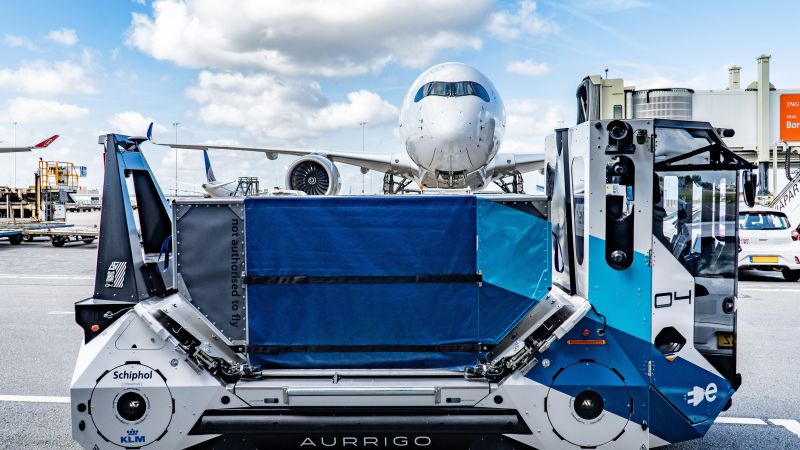
If you ever find yourself in Schiphol Airport in Amsterdam, Changi in Singapore, or Cincinnati/Northern Kentucky International Airport, you might spot some unusual, futuristic-looking vehicles — fully electric, self-driving, and designed to help move baggage and people around.
The three airports are among those where British company Aurrigo, a pioneer in autonomous vehicles for airports, is testing its products.
After delivering a prototype to British Airways in 2019, Aurrigo deployed the first of its autonomous ground vehicles, the Auto-DollyTug, to Changi Airport in 2022.
The Auto-DollyTug — which has a safety driver on board — can autonomously pick up a container and transport it directly to the aircraft. It can go backward, forward and sideways, or rotate 360 degrees on the spot, a handy feature in congested airports where other vehicles are transporting fuel, water, catering and people.
“We are the first globally to have a vehicle and tech that can operate from the baggage hall right up to the aircraft side, to unload and load containers automatically,” said David Keene, CEO of Aurrigo, who’s also a visiting professor at Coventry University, specializing in autonomous vehicles. He founded the company more than 30 years ago as an automotive parts supplier, before developing an interest in automation.
The automotive business continues — supplying electronic systems and feature development for the likes of Jaguar Land Rover, Aston Martin, Bentley and Rolls Royce, Keene said. But the focus of Aurrigo is now aviation, particularly the airside, or the area of an airport beyond the security checkpoints, where planes are loaded and unloaded.
“There is a big hole in the market,” Keene says about the relatively slow adoption of autonomous technologies in aviation, “and there’s going to be a transformation, globally, in the way we move baggage and cargo around an airport and, in the future, in how we might move jet bridges (passenger bridges), stairs, catering wagons — everything’s got the opportunity to be automated.”
Integrating into airports
A switch to self-driving, electric ground vehicles would be a significant change for most airports, where current fleets mostly run on diesel fuel. “Electrification in airports is not as easy as it first sounds,” said Keene. “Not only do you need to swap the diesel vehicles for electric ones, but you need to be able to charge them, and you might not have enough capacity in the grid to support that.”
Then there is the problem of regulations, as no standard exists for bringing an automated vehicle into an airport. “We have to work with each airport and the local authority, and by doing that, we can come to a consensus as to what’s the safest way to implement those vehicles,” Keene said.
That’s one of the reasons why Aurrigo still includes a driver’s seat and a steering wheel.
Earlier this year, the US Federal Aviation Administration (FAA) released guidance on what it calls “autonomous ground vehicle systems” (AGVS), saying that it “enthusiastically welcomes innovative implementation of this new entrant technology, but above all, must ensure that it is integrated safely into active airport environments.”
Part of the guidance mandates that autonomous vehicles in US airports can only be used for testing and in “non-movement areas,” which means away from where aircraft are loaded and unloaded.
Keene believes that there is a strong business case for autonomy, which might eventually be the driver of a regulation breakthrough. “The amount of passenger and cargo operations that airports and airlines are experiencing right now is past pre-Covid levels,” he said. “There is growth in the industry, but not enough people to service it. Automation can top up and help the people that are already there. We’re not making anybody redundant — we’re supplementing. We can move people, or we can move baggage, or we can move cargo around without using as many people as would be required today, to enable that extra staff to be redeployed elsewhere.”
Autonomous advantages
A switch from a traditional diesel fleet to electric, autonomous vehicles could cut carbon emissions by up to 60%, according to Keene, but would also bring another advantage: fewer accidents. As airports become busier, more vehicles are needed to tend to aircraft, and ground damage — instances where vehicles hit each other or collide with aircraft — is a significant problem. The International Air Transport Association (IATA) estimated that the global cost of these accidents could reach $10 billion a year by 2035.
Keene said that so far, no Aurrigo vehicles have been involved in accidents, and that when they are being tested at an airport, any intervention of the human driver must be reported. He added that the number of reported interventions has been “very, very low.”
Aurrigo, which currently has around 120 employees, has two other types of vehicles in the testing phase, the Auto-Cargo — a supersized version of Auto-DollyTug, for cargo operations, which the company says has attracted interest from UPS — and the Auto-Shuttle, a 10-seat vehicle for moving crew to an aircraft or passengers between terminals.
“We believe that with partners like Aurrigo we are gearing towards an airport with self-driving vehicles at the heart of its operations,” Jan Zekveld, the head of innovation at Royal Schiphol Group, which manages Schiphol Airport, told CNN. “Autonomous technology will help us shape safer, cleaner and more resilient airport operations and we’re very keen to explore how to build towards this envisioned future.”
Earlier this year, Aurrigo announced an agreement with Swissport, which manages more than 270 airports worldwide, to test its vehicles and systems. The company is also deploying its Auto-Shuttle and Auto-DollyTug systems at Teesside Airport, a small international airport in Northern England. For now, none of Aurrigo’s vehicles operate on commercial flights. Keene believes the first commercial deployment could happen as early as 2026.
Autonomous systems in airports are on the rise and trial programs are popping up across the globe. Beginning in 2024, KLM tested small autonomous busses by New Zealand company Ohmio at Schiphol Airport. At Hamad International Airport in Doha, Qatar, autonomous vehicles including a bus and a baggage tractor from Chinese manufacturer UISEE have been in tests since February. In July, autonomy company EasyMile rolled out a fleet of six electric baggage tractors at Dubai’s Al Maktoum International Airport.
Battling the elements
According to Piotr Grobelny, an aviation analyst at consultancy firm IBA, rising passenger traffic and the FAA’s openness to autonomy are signals that the sector has potential for growth. He advocates that the airport environment is ideal for self-driving vehicles. “The regulated nature of airports, often cited as a barrier, may paradoxically offer a comparative advantage,” he said in an email.
“Unlike urban roads, characterized by unpredictable human behavior, airports present highly structured, monitored environments with fixed routes and known operations. This predictability may reduce scenario variability and allow (autonomous) systems, if precisely calibrated, to perform moderately reliably within tightly controlled corridors.”
Grobelny indicates preliminary results from Aurrigo’s tests across various airports are encouraging, but noted that technical challenges remain, particularly with inclement weather. Snow, fog and rain are known to impair the perception systems of autonomous systems, and the technologies that can counteract this are still unproven.
Then there is the issue of regulation. “The FAA’s safety criteria explicitly note that autonomous vehicles introduce operational complexities not initially considered in existing standards, underscoring the continuing need for rigorous evaluation and integration protocols,” he said.
Aurrigo says it is tackling weather-related challenges with software that can differentiate between drops of rain and objects, as well as housing critical sensors in housings designed to protect them from heavy rain and snow.
“Baggage and cargo handling hasn’t really moved forward in the last 30 or 40 years, so we’re a bit of a disruptor,” said Keene.



